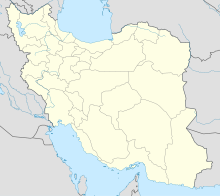Haft Tepe
Coordinates: 32 ° 4 ′ 49 ″ N , 48 ° 19 ′ 41 ″ E
Haft Tepe (or Haft Tape , Persian هفت تپه, 'Seven Hills') is the name of a collection of ruined mounds in the Khuzestan Province of Iran , about ten kilometers southeast of Susa . As one could see from the clay tablets , the only partially excavated Elamite site is the ancient Kabnak . Most of the buildings were probably built in the 14th century BC. Built by King Tepti-Ahar . Before the time of Tepti-Ahar, the place appears to have been uninhabited. An exception is a settlement from the 5th millennium on one of the hills, which only existed for a short time. After the end of the Middle Elamite period, Haft Tepe was only in the Parthianor Sassanid period repopulated.
Research history
The ruins were first described by Jacques de Morgan in 1908. Excavations took place there from 1965 to 1978 under the direction of Ezat O. Negahban, in particular the three central and highest protruding mounds were examined. Preparatory geophysical measurements were carried out in 2002, which provided a complete overview of the building structures in Haft Tappeh, and since 2003 a German-Iranian team has been digging under the direction of Behzad Mofidi-Nasrabadi from the University of Mainz . The project is funded by the German Research Foundation (DFG).
Excavations
During the investigations in Haft Tepe, a 14.5 meter high core of unfired adobe bricks was found in the middle hill, the original height of which was at least 30 meters and which is probably a ziggurat . The consecration offerings indicate a female deity responsible for fertility. Around the ziggurat there were various open courtyards and halls in which supplies were stored and managed. A workshop with a special furnace for firing large quantities of ceramics and for melting metals was also part of the facility.
The remains of a second ziggurat are presumably under the nearest hill, which is less excavated. The remaining height is 17 meters. According to this, there would have been a large sanctuary in old Kabnak with two ziggurats close to each other.
To the northwest of the two ziggurats, a temple complex was excavated, which is surrounded by unbaked clay brick masses and was only accessible from the south. Two halls can be reached from a paved courtyard via a transverse room, behind each of which there is a vault made of fired bricks. The western vault is considered to be the burial chamber of Tepti-Ahar. It is 3.25 meters wide, 10.25 meters long and 3.75 meters high and contained at least 14 severely crumbled skeletons. The second grave complex has an equally large vaulted grave. There were 23 skeletons in it. In both cases, the unusual arrangement of the skeletons is a mystery.
Finds
During the excavations in the area of the middle hill, hundreds of dedicatory offerings, clay figures made using press molds, were found. Above all, it was naked women who gripped their breasts with both hands. The grounds were richly decorated. There were bronze plates with figures and remains of wall paintings. From the halls around the ziggurat, broken clay vessels and numerous seal impressions from closures for vessels and boxes bear witness to the storage of supplies from taxes to the sanctuary. Thousands of clay tablets were also discovered. Most of the texts are written in Akkadian . The analysis of written documents found so far in the form of clay tablets and cylinder seals is not yet complete. These are letters, administrative texts, but also school texts that indicate that scribes were also trained in Detention Tepe.
Numerous finds can be viewed in a small museum on the edge of the 1500 by 800 meter ruins, including various clay containers for burials that were found outside the burial chambers. Two ornate heads and a mask made of painted, unfired clay with distinctive almond-shaped eyes were found in the sanctuary's workshop. They are exhibited today in the Susa Museum.
literature
- Daniel T. Potts: The Archeology of Elam , Cambridge University Press, Cambridge 1999, 196-205
- Heidemarie Koch: Women and Snakes, Mysterious Culture of the Elamers in Old Iran , Verlag Zabern 2007, pp. 118–128, ISBN 978-38053-3737-3
- Heyda Seyed-Ashraf: Elam - an old culture in Iran , Books on Demand, Norderstedt 2008, ISBN 978-3-8334-7336-4
- Ezat O. Negahban: Excavations at Haft Tepe , Philadelphia 1991, ISBN 978-0934718899
- Behzad Mofidi-Nasrabadi : Archaeological Investigations in Haft Tappeh, Iran , Berlin 2004/2004 (in Archäologische Mitteilungen aus Iran und Turan = AMIT 35/36, pp. 225–239)
Web links
- Haft Tepe at Livius.org (English)
- Report on clay tablets (English)
- Archaeological research in Haft Tepe


